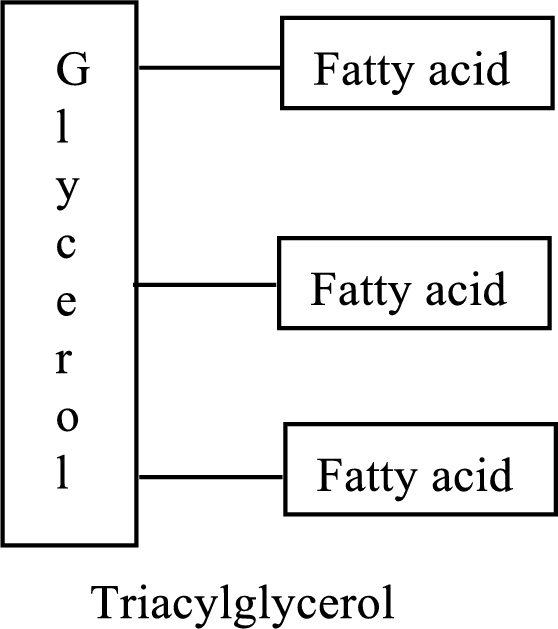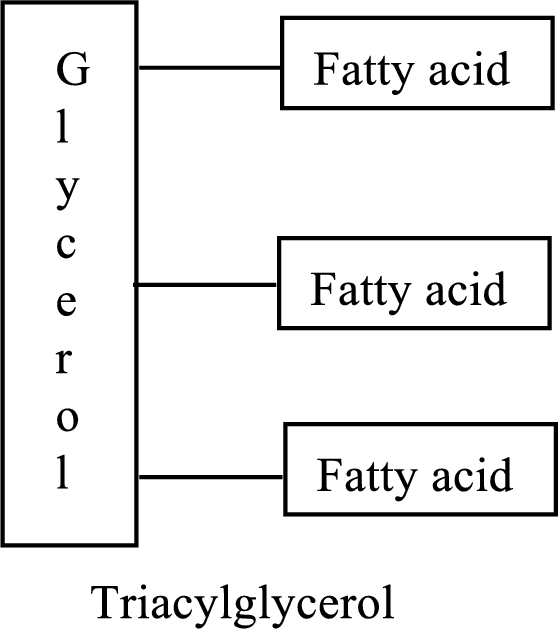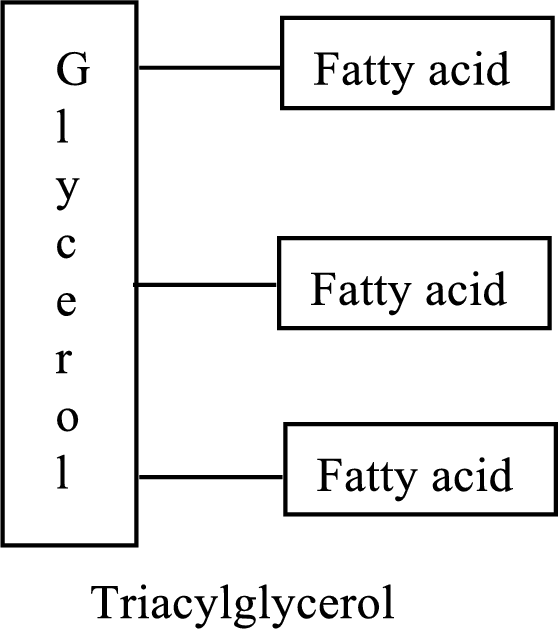
Concept explainers
(a)
Interpretation:
Whether the statement “about 50% of TAGs undergo complete hydrolysis in the stomach” concerning to triacylglycerol(TAG) digestion is true or false has to be determined.
Concept introduction:
Triacylglycerols are lipid molecules which constitute around 98% of the total dietary lipids. These lipid molecules undergo digestion/breakdown into simpler forms in the

(b)
Interpretation:
Whether the statement “cholecystokinin is the chemical name for bile” concerning to triacylglycerol(TAG) digestion is true or false has to be determined.
Concept introduction:
Triacylglycerols are lipid molecules which constitute around 98% of the total dietary lipids. These lipid molecules undergo digestion/breakdown into simpler forms in the digestive system and are later absorbed into the bloodstream. In the bloodstream, the hydrolysis products of triacylglycerols (fatty acids and glycerol) are absorbed by the body cells and are either broken down into acetyl CoA or stored as lipids for future use. Fats/Lipids are a richer source of energy compared to carbohydrates. While carbohydrates provide energy for immediate use, lipids provide energy for long term or future use. The structure of triacylglycerols is as follows:

(c)
Interpretation:
Whether the statement “most TAGs usually enter the small intestine in the form of monoacylglycerols” concerning to triacylglycerol(TAG) digestion is true or false has to be determined.
Concept introduction:
Triacylglycerols are lipid molecules which constitute around 98% of the total dietary lipids. These lipid molecules undergo digestion/breakdown into simpler forms in the digestive system and are later absorbed into the bloodstream. In the bloodstream, the hydrolysis products of triacylglycerols (fatty acids and glycerol) are absorbed by the body cells and are either broken down into acetyl CoA or stored as lipids for future use. Fats/Lipids are a richer source of energy compared to carbohydrates. While carbohydrates provide energy for immediate use, lipids provide energy for long term or future use. The structure of triacylglycerols is as follows:

(d)
Interpretation:
Whether the statement “chyme produced in the stomach settles to the bottom of the stomach” concerning to triacylglycerol(TAG) digestion is true or false has to be determined.
Concept introduction:
Triacylglycerols are lipid molecules which constitute around 98% of the total dietary lipids. These lipid molecules undergo digestion/breakdown into simpler forms in the digestive system and are later absorbed into the bloodstream. In the bloodstream, the hydrolysis products of triacylglycerols (fatty acids and glycerol) are absorbed by the body cells and are either broken down into acetyl CoA or stored as lipids for future use. Fats/Lipids are a richer source of energy compared to carbohydrates. While carbohydrates provide energy for immediate use, lipids provide energy for long term or future use.
The structure of triacylglycerols is as follows:

Want to see the full answer?
Check out a sample textbook solution
Chapter 14 Solutions
Organic And Biological Chemistry
- Show how to convert ethyl benzene to (a) 2,5-dichlorobenzoic acid and (b) 2,4-dichlorobenzoic acid.arrow_forwardHelp me solve this problem. Thank you in advance.arrow_forward22.7 Predict the monoalkylated products of the following reactions with benzene. (a) AlCl3 Ya (b) AlCl3 (c) H3PO4 (d) 22.8 Think-Pair-Share AICI3 The reaction below is a common electrophilic aromatic substitution. SO3 H₂SO4 SO₂H (a) Draw the reaction mechanism for this reaction using HSO,+ as the electrophile. (b) Sketch the reaction coordinate diagram, where the product is lower in energy than the starting reactant. (c) Which step in the reaction mechanism is highest in energy? Explain. (d) Which of the following reaction conditions could be used in an electrophilic aro- matic substitution with benzene to provide substituted phenyl derivatives? (i) AICI3 HNO3 H₂SO4 K2Cr2O7 (iii) H₂SO4 (iv) H₂PO₁arrow_forward
- Is an acid-base reaction the only type of reaction that would cause leavening products to rise?arrow_forwardHelp me understand this! Thank you in advance.arrow_forward22.22 For each compound, indicate which group on the ring is more strongly activating and then draw a structural formula of the major product formed by nitration of the compound. Br CHO (a) CH3 (b) (c) CHO CH3 SO₂H (d) ☑ OCHS NO₂ (e) (f) CO₂H NHCOCH3 NHCOCH, (h) CHS 22.23 The following molecules each contain two aromatic rings. (b) 000-100- H3C (a) (c) Which ring in each undergoes electrophilic aromatic substitution more readily? Draw the major product formed on nitration.arrow_forward
- V Consider this step in a radical reaction: Br: ? What type of step is this? Check all that apply. Draw the products of the step on the right-hand side of the drawing area below. If more than one set of products is possible, draw any set. Also, draw the mechanism arrows on the left-hand side of the drawing area to show how this happens. ⚫ionization termination initialization neutralization none of the abc Explanation Check 80 Ο F3 F1 F2 2 F4 01 % do5 $ 94 #3 X 5 C MacBook Air 25 F5 F6 66 ©2025 ˇ F7 29 & 7 8arrow_forwardShow how to convert ethyl benzene to (a) 2,5-dichlorobenzoic acid and (b) 2,4-dichlorobenzoic acid.arrow_forwardno aiarrow_forward
- Polymers may be composed of thousands of monomers. Draw three repeat units (trimer) of the polymer formed in this reaction. Assume there are hydrogen atoms there are hydrogen atoms on the two ends of the trimer. Ignore inorganic byproducts.arrow_forwardDraw a tetramer if this alternating copolymer pleasearrow_forwardDraw the monomers required to synthesize this condensation polymer.arrow_forward
 General, Organic, and Biological ChemistryChemistryISBN:9781285853918Author:H. Stephen StokerPublisher:Cengage Learning
General, Organic, and Biological ChemistryChemistryISBN:9781285853918Author:H. Stephen StokerPublisher:Cengage Learning Organic And Biological ChemistryChemistryISBN:9781305081079Author:STOKER, H. Stephen (howard Stephen)Publisher:Cengage Learning,
Organic And Biological ChemistryChemistryISBN:9781305081079Author:STOKER, H. Stephen (howard Stephen)Publisher:Cengage Learning, Chemistry for Today: General, Organic, and Bioche...ChemistryISBN:9781305960060Author:Spencer L. Seager, Michael R. Slabaugh, Maren S. HansenPublisher:Cengage Learning
Chemistry for Today: General, Organic, and Bioche...ChemistryISBN:9781305960060Author:Spencer L. Seager, Michael R. Slabaugh, Maren S. HansenPublisher:Cengage Learning Introduction to General, Organic and BiochemistryChemistryISBN:9781285869759Author:Frederick A. Bettelheim, William H. Brown, Mary K. Campbell, Shawn O. Farrell, Omar TorresPublisher:Cengage Learning
Introduction to General, Organic and BiochemistryChemistryISBN:9781285869759Author:Frederick A. Bettelheim, William H. Brown, Mary K. Campbell, Shawn O. Farrell, Omar TorresPublisher:Cengage Learning Chemistry In FocusChemistryISBN:9781305084476Author:Tro, Nivaldo J., Neu, Don.Publisher:Cengage Learning
Chemistry In FocusChemistryISBN:9781305084476Author:Tro, Nivaldo J., Neu, Don.Publisher:Cengage Learning




